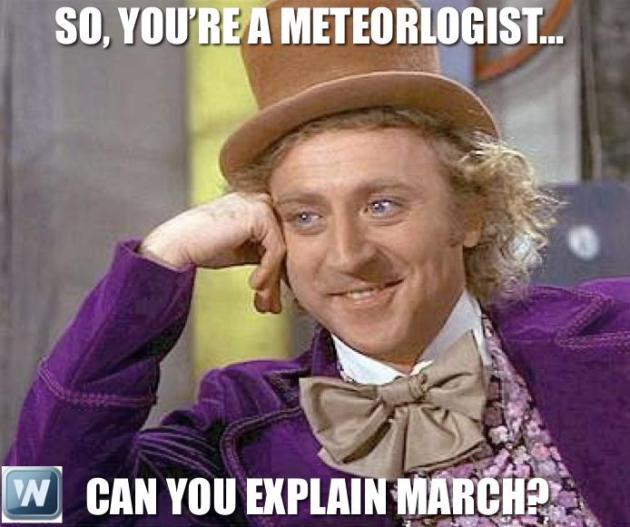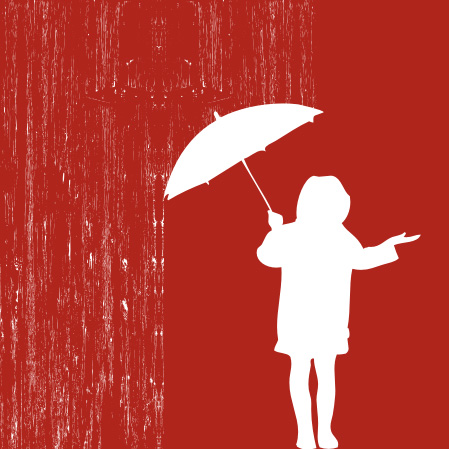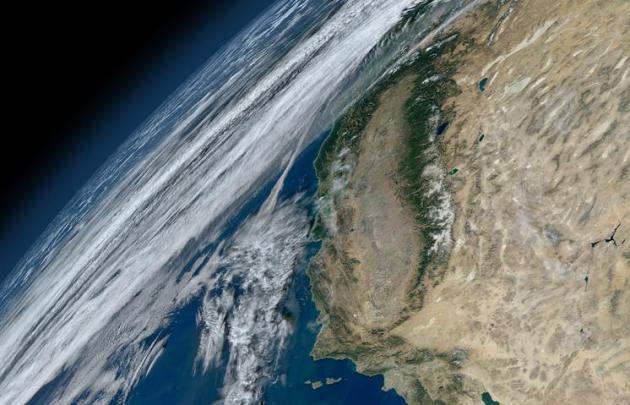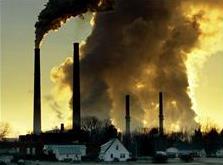45 F. average high on March 24.
47 F. high on March 24, 2016.
March 25, 2007: Record warmth stretches from southern Minnesota to western Wisconsin with 72 at Owatonna, 77 at Menomonie, WI, and 80 at Eau Claire, WI.
March 25, 1981: An F2 tornado hits Morrison county and does $25,000 worth of damage.

A Windier Than Normal March Across Minnesota
I never fail to marvel at the number of Minnesotans who walk around in shorts when the temperature is below zero. Mostly young people. A silent protest? In Seattle many locals walk around in the rain with no umbrella to shield them. Life goes on, in a steady, wind-whipped drizzle.
Which got me thinking: would I get ANYTHING done if I lived in Florida, Arizona or southern California? Probably not.
According to Mark Seeley March has been unusually windy; an average daily wind speed over 12 mph - 9 days with gusts over 30.
The transition from winter to summer always leaves the atmosphere in a foul, potentially destructive mood. The lower atmosphere is warming due to a higher sun angle, while the upper atmosphere is still cold - suffering from a wintry hangover. The result can and will be severe storms and random tornadoes within a month or two.
Today looks like the drier day of the weekend; more rain showers tonight and Sunday. Highs surge into the 50s next week, and big storms track well south of Minnesota.
Spring is coming, however reluctantly. Kinder, gentler days ahead.

Parade of Storms. I keep waiting for a break in the pattern, the Conga-line of sloppy storms pushing into the west coast, reinvigorated by moisture from the Gulf of Mexico. More heavy rain pushes into Seattle and Portland Sunday before pushing inland, dumping out more heavy snow from the Cascades to the Rockies. Meanwhile we're keeping an eye on a system near the Bahamas which could (in theory) strengthen into a tropical storm in the coming days. 12 KM NAM guidance: NOAA and Tropicaltidbits.com.
Gizmodo has more details on the fast-moving flames that chased people from their homes and created a massive death toll among cattle in the southern Plains.


Image credit: "Erik Rasmussen, VORTEX-SE project manager and NOAA senior research scientist, speaks about the research at Signature Aviation with a NOAA Lockheed WP-3S Orion aircraft in the background. The WP-35, nicknamed Kermit, has been brought to Huntsville to support VORTEX-SE."
Minnesota Tornadoes Since 1950. No need to fear Otter Tail county (73 confirmed tornadoes from 1950 to 2015). The reason there were so many? The size of the county. Then again proximity to chilly Lake Superior water has meant only 2 tornadoes in Cook County during the same period, probably the safest place in the state to ride out tornado season. Graphic: Minnesota DNR.
New Cloud Types Defined by WMO. The UK Met Office has details: "The cloud species Volutus has been officially named as a new species of cloud in the World Meteorological Organization’s Cloud Atlas. The new cloud species name will now be used by meteorologists operationally around the world. As well as a new species, several new ‘special clouds’ and supplementary features of existing cloud types have been officially recognised in the atlas which is the official publication of cloud types. It is used as a reference document by operational meteorologists around the world and is also an important training tool for meteorologists, as well as for those working in aviation and at sea. Special clouds named in the new edition include: Flammagenitus, which are clouds formed as a result of forest fires; and Homogenitus, which denotes man-made or anthropogenic clouds such as those which form over power station cooling towers. An example of a new supplementary feature is Asperitas, which are well defined wave-like structures in the underside of clouds..."
More new entries in the WMO (World Meteorological Organization) Cloud Atlas:
Melting Arctic Worsens Beijing's Pollution Haze, Study Finds. Because everything is interconnected. Here's an excerpt from Climate Home: "The melting of the Arctic Ocean sea ice and the greater falls of snow in Siberia may be responsible for stagnant air conditions that cast a polluting haze over Beijing and the East China plains in January 2013, according to new research. Smoke from power stations, car exhausts and factory chimneys must have contributed. But a month-long episode of severe and choking air pollution that made world headlines now seems to have been made possible by climate changes that shifted China’s winter monsoon, to trap tiny floating particles of soot and dust over the nation’s biggest cities and industrial centers. If so, the haze could get worse, as the Arctic goes on warming and the northern latitudes get the extra burden of snow..."
Photo credit: "Beijing’s air pollution typically intensifies in winter." (Pic: J Aaron Farr/Flickr)
Clouds
may also develop as a consequence of human activity. Examples are
aircraft condensation trails (contrails), or clouds resulting from
industrial processes, such as cumuliform clouds generated by rising
thermals above power station cooling towers. Clouds that are clearly
observed to have originated specifically as a consequence of human
activity will be given the name of the appropriate genus, followed by
the special cloud name “homogenitus”. For example, Cumulus cloud formed
above industrial plants will be known as Cumulus (and, if appropriate,
the species, variety and any supplementary features) followed by the
special cloud name homogenitus; for example, Cumulus mediocris homogenitus. - See more at: https://www.wmocloudatlas.org/homogenitus.html#sthash.WGzVNilv.dpuf
Clouds
may also develop as a consequence of human activity. Examples are
aircraft condensation trails (contrails), or clouds resulting from
industrial processes, such as cumuliform clouds generated by rising
thermals above power station cooling towers. Clouds that are clearly
observed to have originated specifically as a consequence of human
activity will be given the name of the appropriate genus, followed by
the special cloud name “homogenitus”. For example, Cumulus cloud formed
above industrial plants will be known as Cumulus (and, if appropriate,
the species, variety and any supplementary features) followed by the
special cloud name homogenitus; for example, Cumulus mediocris homogenitus. - See more at: https://www.wmocloudatlas.org/homogenitus.html#sthash.WGzVNilv.dpuf
Photo credit: "Not an ideal neighbor." (AP Photo/Gerry Broome).
Map credit: "If only Eisenhower had known… he would totally have still built these roads." (Bureau of Transportation Statistics).
Solar Employs More People in U.S. Electricity Generation Than Oil, Coal and Gas Combined. Here's a clip from The Center for Climate Protection: "In the United States, more people were employed in solar power last year than in generating electricity through coal, gas and oil energy combined. According to a new report from the U.S. Department of Energy, solar power employed 43 percent of the Electric Power Generation sector’s workforce in 2016, while fossil fuels combined accounted for just 22 percent. It’s a welcome statistic for those seeking to refute Donald Trump’s assertion that green energy projects are bad news for the American economy. Just under 374,000 people were employed in solar energy, according to the report, while coal, gas and oil power generation combined had a workforce of slightly more than 187,000. The boom in the country’s solar workforce can be attributed to construction work associated with expanding generation capacity. The gulf in employment is growing with net generation from coal falling 53 percent over the last decade. During the same period, electricity generation from natural gas increased 33 percent while solar expanded 5,000 percent..."
Photo credit: "Residents of Pueblo protest high electric rates." CREDIT: Pueblo’s Energy Future.

The Hidden Risks of Trump's EPA Cuts: Birth Defects, Bad Air. Bloomberg reports: "President Donald Trump pledged during the 2016 campaign that he would only "leave a little bit" of federal rules that protect human health and the environment. Now about 50 former officials of the U.S. Environmental Protection Agency are firing back in a lengthy analysis that details, program by program, what amounts to a starvation diet for the EPA. Calling themselves the Environmental Protection Network, they worked through both Republican and Democratic administrations. The group's members are putting aside their differences over policies and programs to stop what they say "appears to be nothing less than a full-throttle attack on the principle underlying all U.S. environmental laws—that protecting the health and environment of all Americans is a national priority..."
Drake Equation Revision Hugely Ups Odds Intelligent Extraterrestrial Life Exists.
Maybe so, but where are the aliens. Could it be they've sampled our TV
shows and want nothing to do with us? Here's an excerpt from Inverse: "Mankind
doesn’t explore space solely in search of extraterrestrials, but we
keep our eyes peeled. Still, scientists know that the chances of
happening across a fellow traveler in the great beyond are minimal — and
they wrap their heads around the infinitesimal odds using the Drake Equation,
a seven-variable way of deriving the chance of active civilizations
existing beyond Earth. But equations get older and equations get wrong.
The Drake Equation, which takes into account various factors like the
rate of star formation, the fraction of stars that could form planetary
systems, the number habitable planets in those systems, and so on, is
now 55 years old. It doesn’t reflect the new information SETI
researchers have collected since the 1960s..."
"Sea of Despair" Among White, Working-Class Americans. Industries are being disrupted, jobs automated; companies making do with fewer employees. A Washington Post article claims it's not just blue collar America that's feeling the heat: "Sickness
and early death in the white working class could be rooted in poor job
prospects for less-educated young people as they first enter the labor
market, a situation that compounds over time through family dysfunction,
social isolation, addiction, obesity and other pathologies, according
to a study published Thursday by two prominent economists. Anne Case and Angus Deaton garnered national headlines in 2015 when they reported
that the death rate of midlife non-Hispanic white Americans had risen
steadily since 1999 in contrast with the death rates of blacks,
Hispanics and Europeans. Their new study extends the data by two years
and shows that whatever is driving the mortality spike is not easing up.
The two Princeton professors say the trend affects whites of both sexes
and is happening nearly everywhere in the country..."
Let Robots Handle Your Emotional Burnout at Work.
Then again, maybe robotics and automation will keep us from going
crazy? Here's an excerpt of a more hopeful perspective on automation at How We Get To Next: "...Over
three decades later, working in a service job still demands the stamina
and resilience to handle a barrage of customer complaints—and often
even abuse—with a smile. Professions that require emotional labor, which
involves inducing or suppressing emotion for the sake of a job,
continue to see unprecedented levels of attrition, especially among customer service representatives, flight attendants, doctors, nurses, school teachers, and hotel employees.
But as robotics and computing evolve, some researchers foresee a future
where technology can relieve the long-held emotional burden of some of
these professions. They think we owe it to the service workforce to
offer a new frontline of robotic protection. In fact, they think it’s
far overdue—but does that actually mean just automating these jobs away?..."
Image credit: Darren Garrett
Amazon, The World's Most Remarkable Firm, is Just Getting Started. Here's a clip from The Economist: "...In
e-commerce, the more shoppers Amazon lures, the more retailers and
manufacturers want to sell their goods on Amazon. That gives Amazon more
cash for new services—such as two-hour shipping and streaming video and
music—which entice more shoppers. Similarly, the more customers use
AWS, the more Amazon can invest in new services, which attract more
customers. A third virtuous circle is starting to whirl around Alexa,
the firm’s voice-activated assistant: as developers build services for
Alexa, it becomes more useful to consumers, giving developers reason to
create yet more services..."
Image credit: Wikimedia / donatas1205 / Billion Photos / vgeny Karandaev / The Atlantic.
Photo credit: "Streaming and mobile video has made it so much easier to binge." (AP/Eric Charbonneau/Invision for Showtime).

“What does love look like? It has the hands to help others. It has the feet to hasten to the poor and needy. It has the eyes to see misery and want. It has the ears to hear the sighs and sorrows of men. That is what love looks like.” - Augustine
TODAY: Mostly cloudy - peeks of sun possible. Winds: NE 10-15. High: 48
SATURDAY NIGHT: Few showers possible. Low: 36
SUNDAY: Cool and damp. Few showers over eastern Minnesota. Winds: NE 7-12. High: 44
MONDAY: More clouds than sun, could we worse. Winds: N 7-12. Wake-up: 37. High: near 50
TUESDAY: More sun, feels like spring again. Winds: NE 7-12. Wake-up: 39. High: 55
WEDNESDAY: Fading sun, late-day shower risk. Winds: SE 7-12. Wake-up: 40. High: 54
THURSDAY: Steadier, heavier rain possible. Winds: NE 10-15. Wake-up: 42. High: 53
FRIDAY: Sun returns, better outdoor day. Winds: N 10-15. Wake-up: 38. High: 55
Climate Stories...
Climate Change Signal in Great Plains Wildfires? Is the unusual warmth that helped to create conditions favorable for record wildfires over the southern Plains related to background warming, or just a random event? Here's an excerpt from Climate Signals: "...Since the 1970s, large grass and shrubland fires have increased by more than 100,000 acres per decade. The frequency and intensity of wildfires in the Great Plains are increasing as the combination of higher temperatures, untamed underbrush and more extreme drought elevate wildfire risk. Formal attribution work has identified the fingerprint of global warming in the record hot temperatures that swept across the US east of the Rockies in February 2017, as climate change increased the likelihood of such heat by threefold. The heat fueled worsening drought conditions in the Great Plains region, contributing to the extreme fire conditions in early March that precipitated major blazes in Kansas, Oklahoma, Colorado, and Texas. One blaze, encompassing Clark and Comanche counties along Kansas' southern border with Oklahoma, is the largest wildfire on record in the state..."
Global Warming is Increasing Rainfall Rates. Here's an excerpt of a story from Dr. John Abraham at the University of St. Thomas, writing for The Guardian: "...In my state, we have had four 1000-year floods since the year 2000! Two years ago, Minneapolis, Minnesota had such flooding that people were literally fishing in the streets as lakes and streams overflowed and fish escaped the banks. No joke, I actually observed fish swimming past me as I waded up a street. This occurrence is being observed elsewhere in my country and around the world. It falls upon city planners and engineers to design infrastructure that is more able to accommodate heavy rains and manage water. This means designing river containment areas or flood plains, reinforcing buildings and houses, and increasing the capacity of storm drainage in urban areas, just to name a few. These modifications present costs but not preparing for increased flooding poses even greater financial and social costs. Moreover, storing water from times when there is too much for the inevitable times when we have too little (drought), results in better water management and multiple benefits..."
Photo credit: "Jared Bakko hauls a boat down a flooded road after taking supplies to his grandmother as the Red River flood waters began to recede just south of Moorhead, Minnesota, USA, 28 March, 2009." EPA/CRAIG LASSIG Photograph: Craig Lassig/EPA.
Photo credit: "Spring is arriving earlier, and the vernal window is lasting longer." ellenm1 / Flickr, http://michrad.io/1LXrdJM.
Image credit: "On March 7, Arctic sea ice hit a record low wintertime maximum extent." (L. Perkins/NASA Goddard Scientific Visualization Studio).
Accelerating Meltdown. From Climate Nexus: "For the third year running, Arctic sea ice hit a record low for its annual peak extent of winter ice cover, scientists reported Wednesday. According to the National Snow and Ice Data Center (NSIDC), sea ice cover reached its peak extent on March 7 at 5.57 million square miles – over 470,000 square miles, an area the size of South Africa, smaller than the 1981-2010 long-term average, and 37,000 square miles smaller than the 2015 record. The meager ice cover comes after a disturbingly warm winter in the region, and NSIDC reports temperatures 4.5°F above average from October to February. The ice is "a key part of the Earth's climate system and we're losing it," NSDIC director Mark Serreze told the AP. "We're losing the ice in all seasons now."
* The 28 page WMO (World Meteorological Organization) report on the climate is here.
No comments:
Post a Comment